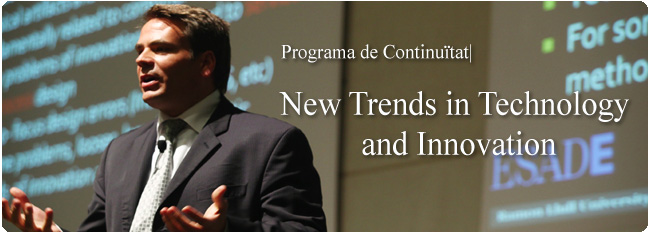Summary of the book:
The knowledge-creating company: How japanese companies create the dynamics of innovation – Nonaka and Takeushi (1995)
- Introduction to knowledge organizations
- Knowledge and management
- Theory of organizational knowledge creation
- creating knowledge in practice
- Middle-up-down management process for knowledge creation
- A new organizational structure
- Global organizational knowledge creation
- Managerial and theoretical implications
1.- Introduction to knowledge organizations
- Three key characteristics of knowledge creation:
- Metaphor and analogy
- From personal to organizational knowledge
- Although we use the term “organizational” knowledge creation, the organization cannot create knowledge on its own without the initiative of the individual and the interaction that takes place within the group. –p13
- Ambiguity and redundancy
- Ambiguity can prove useful at time not only as a source of a new sense of direction, but also as a source of alternate meanings and a fresh way of thinking about things. In this respect, new knowledge is born of chaos – p14
- Redundancy is important because it encourages frequent dialogue and communication. This helps create a “common cognitive ground” among employees and thus facilitates the transfer of tacit knowledge. – p14
2.- Knowledge and management
3.- Theory of organizational knowledge creation
- Epistemological dimension: explicit knowledge / tacit knowledge
- Ontological dimension: knowledge level (individual/group/organization/inter-organization)
| Tacit knowledge (subjective) |
Explicit Knowledge (objective) |
| Knowledge of experience (body) | Knowledge of rationality (mind) |
| Simultaneous knowledge (here and now) | Sequential knowledge (there and then) |
| Analog knowledge (practice) | Digital knowledge (theory) |
- Four modes of knowledge conversion
- Socialization: from tacit to tacit
- Externalization: from tacit to explicit
- Combination: from explicit to explicit
- Internalization: from explicit to tacit
|
TO |
|||
|
TACIT Knowledge |
EXPLICIT Knowledge |
||
|
FROM |
TACIT Knowledge |
Socialization |
Externalization |
|
EXPLICIT Knowledge |
Internalization |
Combination |
|
- Contents of knowledge and the knowledge spiral
- First, the socialization mode usually starts with building a “field” of interaction. .. sharing of member’s experiences and metal models. Second the externalization mode is triggered by meaningful “dialogue or collective reflection”, in which using appropriate metaphor or analogy…Third, the combination mode is triggered by “networking” newly created knowledge and existing knowledge from other sections of the organization, thereby crystallizing them into a new product, service, pr managerial system. Finally, “learning by doing” triggers internalization. – p71


- tacit knowledge if individuals is the basis of organizational knowledge creation – p72
- The mobilized tacit knowledge is “organizationally” amplified through four modes of knowledge conversion and crystallized at higher ontological levels. We call this the “knowledge spiral” – p72
- This process is exemplified by product development. Creating a product concept involves a community of interacting individuals with different backgrounds and mental models. – p73
- Enabling conditions for organizational knowledge creation:
- Intention: (organization’s aspiration to its goals – p74)
- Autonomy
- Fluctuation and creative chaos (which stimulates the interaction between the organization and the external environment -p78). Chaos is generated naturally when organization faces areal crisis…. it can also be generated intentionally when organization’s leaders try to evoke a “sense of crisis”… by proposing challenging goals.
- Redundancy
- Requisite Variety

- Five-phase Model of the organizational Knowledge-creation process (p83)
- Sharing tacit knowledge
- Creating concepts
- Justifying concepts
- Building an archetype
- cross-leveling of knowledge
- The truly dynamic nature of our theory can be depicted as the interaction of the two knowledge spirals over time. Innovation emerges out of these spirals.
4.- Creating knowledge in practice

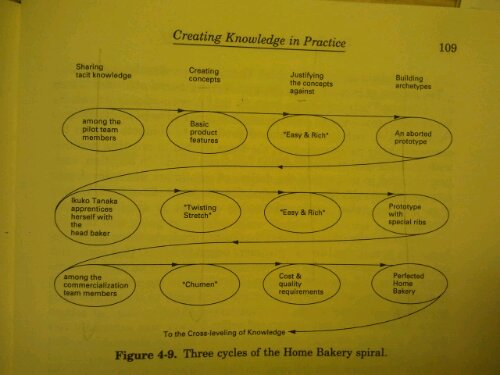
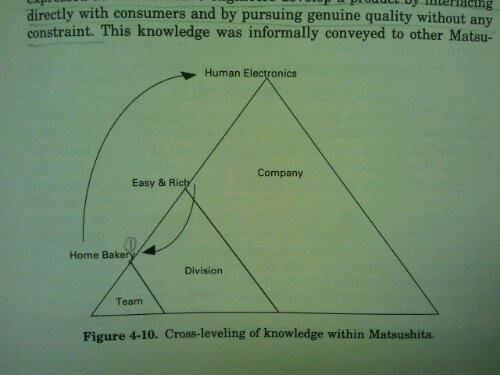
5.- Middle-up-down management Process for Knowledge Creation
- Simply put, knowledge is created by middle managers, who are often leaders fo a team or task force, through a spiral conversion process involving both the top and the front-line employees (i.e. bottom). -p127
- Middle managers are the key to continuous innovation. -p127
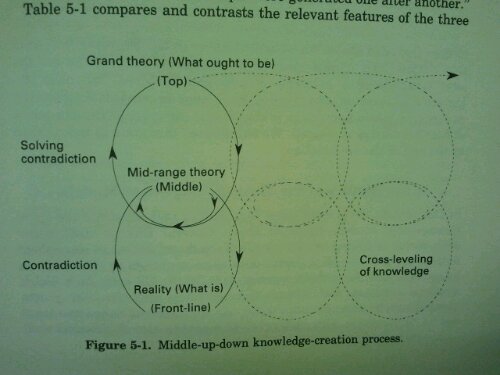

Knowledge-Creating Crew
- In fact, creating new knowledge sis the product of dynamic interaction among the following three players: (1) knowledge practitioners, (2) knowledge engineers, and (3) knowledge officers. -p151
- (1) knowledge practitioners: front-line employees and line managers
- high intellectual standards
- strong sense of commitment to re-create the world according to their own perspective
- wide variety of experiences, both inside and outside the company
- skilled in carrying a dialogue with customers and colleagues
- open to carrying out candid discussions as well as debates with others -p154
- (2) knowledge engineers: middle managers
- capabilities of project coordination and management
- skilled at coming with hypotheses in order to create new concepts
- ability to integrate various methodologies for knowledge creation
- proficient at employing metaphors in order to help others generate and articulate imagination
- engender trust among team members
- ability to envision the future course of action based on an understanding of the past
- (3) knowledge officers: top managers
- ability to aerticulate a knowledge vision in order to gicve a copany’s knowledge-creating activitiesa sense of direction
- capability to communicati the vision, as well as teh corporate culture on whi it is based, to project team members
- capability to justiofy the quaklity of hte created knowledge based on organizatuionap criteria or standards
- uncanny talent for selecting the rioght project ledaer
- willingness to create chaos within the project team by, for example, setting inordinately challenging goals
- skillfulness in intearctign with team members on a hands-on basis and soliciting commitment from them; and
- capability to direct and manage the total process of orgnaizationasl knoweledge creation. -p158
6.- A new organizational structure
In search of a synthesis – the hypertext organization
- A business organization should have a nonhierarchical, self-organizaing structure workign in tandem with its hierarchical formal structure. This potin is particularly important for organizaational knoledge creation -p166
- …hypertext organization is made up of intercoinnected layers or contexts: the business ssystem, the project team, and teh knowledge base. -p167
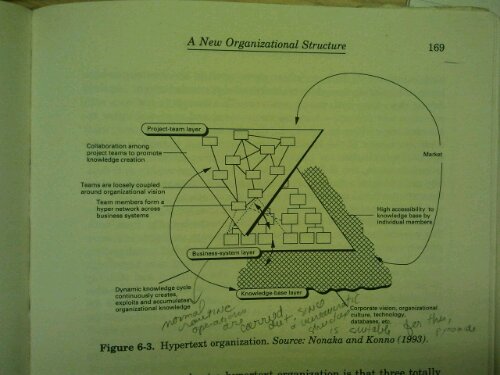
- The central layer is the business layer in which normal, routine operations are carried out. Since a bureacratic structure is suitable for conducting routine work efficiently, this layer is shaped like hierarchical pyramid. The top layer is the “project team” layer, where multiple project teams engage in knowledge creating activities such as new product development… at the bottom is the “knowledge base” layer, where organizational knowledge generated in the above two layers is recatergorized and recontextualized. This layer does not exist as an actual organizational entity, but is embedded in corporate vision, organizational culture, or technology…. While corporate vision and organizational culture provide the knowledge base to tap tacit knowledge, technology taps the explicit knowledge generated in the two other layers… -p168
- the key characteristic of the hypertext organization is the ability of its members to shift contexts –p170
- the efficiency and stability of the bureaucracy is combined with the effectiveness and dynamism of the task force in a hypertext organization. Moreover, it adds another layer, the “knowledge base”, that serves as a clearinghouse for the new knowledge generated in the business system at the project team layers.
- A hypertext organization should not be confused with a matrix structure, which is used to actually two or more different tasks in a conventional hierarchical organization. P170
- in the matrix structure, and organization member must belong or report to two structures at the same time. In contrast, an organization member in a hypertext structure belongs or reports to only one structure at one point in time.
- matrix structure is not primarily oriented toward knowledge conversionin a hypertext organization, knowledge contents are combined more fixedly across layers and over time.
- Since deadlines are set for the projects, the resources and energy of the hypertext organization can be used in a more concentrated manner to fulfill the goal of the project during the project period.
- … in a sense, a hypertext organization fosters middle-up-down management
7.- Global organizational knowledge creation

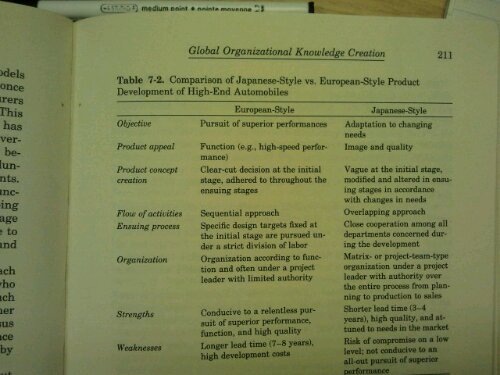
8.- Managerial and theoretical implications
- A summary of our major findings
- tacit and explicit knowledge
- interaction between tacit and explicit knowledge is performed by an individual, not by the organization itself
- the core of the organizational knowledge creation process takes place at the group level, but the organization provides the necessary enabling conditions. The knowledge spiral: invention, autonomy, fluctuation and creative chaos, redundancy, and requisite variety
- organizational knowledge duration is nonlinear and interactive. Is a never-ending iterative process
- middle up down management
- hypertext organization
- we need to integrate the merits of both the Japanese and Western methodologies to develop a universal model of organizational knowledge creation
- practical implications
- create a knowledge vision
- develop a knowledge crew
- Build high density field of interaction at the front line
- Piggyback on the new product development process
- adopt middle-up-down management
- switch to a hypertext organization
- construct a knowledge network with the outside world
- theoretical implications
- false dichotomies
- tacit / explicit
- body / mind
- individual / organization
- top-down / bottom up
- bureaucracy / task force
- relay / rugby
- East / West
OTHER SUMMARIES and COMMENTS:
- http://www.cocreativity.com/handouts/nonaka.pdf
- http://i.org.helsinki.fi/lassial/files/summaries/100120-Nonaka_and_Takeuchi_1995_summary.pdf
- http://km.camt.cmu.ac.th/phdkm/2004_3_cw/Anukul/4%20Literature%20and%20Critical%20Reviews/4.1%20Critical%20Reviews/18-Knowlege%20Creating%20Company%20Summary.pdf
- http://www.icarusproject.org/KM_Course/Harold.htm

